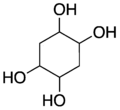Chemistry:Cyclohexanetetrol
A cyclohexanetetrol is a chemical compound consisting of a cyclohexane molecule with four hydroxyl groups (–OH) replacing four of the twelve hydrogen atoms. It is therefore a cyclitol (cyclic polyol). Its generic formula is C6H12O4 or C6H8(OH)4.[1] Some cyclohexanetetrols have biologically important roles in some organisms.[2][3][4][5][6][7][8]
Isomers
There are several cyclohexanetetrol isomers that differ on the position of the hydroxyl groups along the ring, and on their orientation relative to the mean plane of the ring.
The isomers with each hydroxyl on a distinct carbon are:[9]
- 1,2,3,4-Cyclohexanetetrol or ortho- (10 isomers, including 4 enantiomer pairs) [1][10]
- 1,2,3,5-Cyclohexanetetrol or meta- (8 isomers, including 2 enantiomer pairs) [1]
- 1,2,4,5-Cyclohexanetetrol or para- (7 isomers, including 2 enantiomer pairs) [1][3][9]
Possible isomers with two geminal hydroxyls (on the same carbon) are[dubious ]
- 1,1,2,3-Cyclohexanetetrol (4 isomers); hydrate of 2,3-dihydroxy-cyclohexanone
- 1,1,2,4-Cyclohexanetetrol (4 isomers); hydrate of 2,4-dihydroxy-cyclohexanone
- 1,1,3,4-Cyclohexanetetrol (4 isomers); hydrate of 3,4-dihydroxy-cyclohexanone
Possible isomers with two pairs of geminal hydroxyls:
- 1,1,2,2-Cyclohexanetetrol (1 isomer); twofold hydrate of 1,2-cyclohexanedione
- 1,1,3,3-Cyclohexanetetrol (1 isomer); twofold hydrate of 1,3-cyclohexanedione
- 1,1,4,4-Cyclohexanetetrol (1 isomer); twofold hydrate of 1,4-cyclohexanedione
Preparation
The synthesis of cyclohexanetetrols can be achieved by, among other methods: reduction or hydrogenation of (1) cyclohexenetetrols, (2) tri-hydroxycyclohexanones, (3) pentahydroxycyclohexanones, (4) hydroxylated aromatic hydrocarbons, or (5) hydroxylated quinones; the (6) hydrogenolysis of dibromocyclohexanetetrols; the (7) hydration of diepoxycyclohexanes; and the hydroxylation of (8) cyclohexadienes or (9) cyclohexenediols.[9]
See also
- Calditol, cyclohex-5-ene-1,2,3,4-tetrol
- Inositol, 1,2,3,4,5,6-cyclohexanehexol
References
- ↑ 1.0 1.1 1.2 1.3 CON and CBN IUPAC Commissions on Nomenclature (1968): "The Nomenclature of Cyclitols - Tentative Rules". European Journal of Biochemistry, volume 5, pages 1-12. doi:10.1111/j.1432-1033.1968.tb00328.x
- ↑ J. S. Craigie (1969): "Some Salinity-Induced Changes in Growth, Pigments, and Cyclohexanetetrol Content of Monochrysis lutheri". Journal of the Fisheries Research Board of Canada, volume 26, issue 11, pages 2959-2967. doi:10.1139/f69-282
- ↑ 3.0 3.1 Fernando Garza‐Sánchez, David J. Chapman, and James B. Cooper (2009): "Nitzschia Ovalis (Bacillariophyceae) Mono Lake strain accumulates 1,4/2,5 cyclohexanetetrol in response to increased salinity". Journal of Phycology, volume 45, issue 2, pages 395-403. doi:10.1111/j.1529-8817.2009.00667.x
- ↑ E.O. von Lippmann (1901), Chemische Berichte, volume 34, pages 1159-1162.
- ↑ J.D. Ramanathan, J.S. Craigie, J. McLachlan, D.G. Smith, and A.G. McInnes (1966): Tetrahedron Letters, volume 1966, pages 1527-1531.
- ↑ J. S. Craigie, J. McLachlan, and R. D. Tocher (1968): Canadian Journal of Botany, volume 46, pages 605-611.
- ↑ Z. Zeying and Z. Mingzhe (1987): Jiegou Huaxue, volume 1987, pages 128-131
- ↑ Z. Zeying and Z. Mingzhe (1988): Chemical Abstracts, page 167846r.
- ↑ 9.0 9.1 9.2 G. E. McCasland, Stanley Furuta, L. F. Johnson, and J. N. Shoolery (1963): Synthesis of the Five Diastereomeric 1,2,4,5-Cyclohexanetetrols. Nuclear Magnetic Resonance Configurational Proofs. Journal of Organic Chemistry, volume 28, issue 4, pages 894-900. doi:10.1021/jo01039a002
- ↑ Nihat Akbulut and Metin Balci (1988): "A new and stereospecific synthesis of cyclitols: (1,2,4/3)-, (1,2/3,4)-, and (1,3/2,4)-cyclohexanetetrols". Journal of Organic Chemistry, volume 53, issue 14, pages 3338-3342. doi:10.1021/jo00249a039
 |




